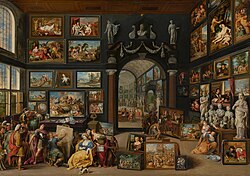This article has multiple issues. Please help improve it or discuss these issues on the talk page . (Learn how and when to remove these messages)
|
Galerij Prins Willem V | |
 The Gallery is on the 2nd floor of the building in the center. On the right is the entrance to both gallery and the adjacent Museum Gevangenpoort | |
 | |
| Established | 1774 |
|---|---|
| Location | The Hague |
| Coordinates | 52°4′45.9″N4°18′37.39″E / 52.079417°N 4.3103861°E |
| Type | Art museum |
| Accreditation | Dutch Museum Association |
| Collections | Dutch Golden Age |
| Collection size | ± 150 |
| Visitors | 29,236 (2017) |
| Founder | William V, Prince of Orange |
| Executive director | Emilie Gordenker |
| Business director | Sander Uitdenbogaard |
| Curator | Ariane van Suchtelen |
| Architect | Philip Willem Schonck |
| Owner | Mauritshuis |
| Public transit access | Kneuterdijk / Lange Vijverberg |
| Nearest car park | Heulstraat |
| Website | Official website |
The Prince William V Gallery is an art gallery on the Buitenhof in The Hague that currently shares an entrance with the Gevangenpoort museum. It is a recreation of the original gallery Galerij Prins Willem V, once founded there by William V, Prince of Orange, in 1774. The displayed paintings are part of the collection of the Mauritshuis. Amongst the paintings on display are works by Peter Paul Rubens, Jan Steen, Paulus Potter and Gerard van Honthorst.























